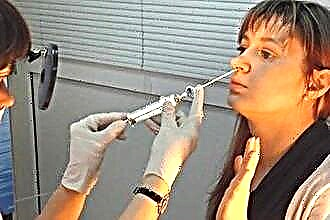Anemization of the nasal mucosa is a medical procedure. It is needed for the treatment and prevention of a number of colds, as well as viral diseases, which are accompanied by inflammatory processes of the mucous tissue in the nasal cavity. During this procedure, the mucous membrane is irrigated with special drugs to narrow the blood vessels. In other words, anemization of the nasal mucosa is a way to artificially induce vasospasm. It is also used to prevent bleeding during surgical procedures in the nasal cavity.
Method essence
 Anemization of the nasal mucosa, as a rule, is combined with conservative methods of treating nasal diseases. Such a procedure safely and quickly eliminates the swelling of the mucous membrane in both minor and serious inflammatory processes.
Anemization of the nasal mucosa, as a rule, is combined with conservative methods of treating nasal diseases. Such a procedure safely and quickly eliminates the swelling of the mucous membrane in both minor and serious inflammatory processes.
For example, procedures such as puncture of the maxillary sinuses, YAMIK catheterization and similar manipulations cause microscopic trauma to the mucous membrane. Puncture of the sinuses is completely accompanied by a violation of their integrity. All this automatically causes moderate to severe bleeding. Anemization of the nasal mucosa can significantly reduce the intensity of blood loss due to vasoconstriction (the more the blood vessels are narrowed, the less blood is in them, respectively, the less pronounced blood loss).
In addition, this procedure relieves swelling of the mucous membrane well. This is easy to explain. The fact is that from the so-called anemic vessels, the liquid enters the tissues in a much smaller amount than in the case of their plethora.
Other additional methods can be used in conjunction with anemization:
- suction of mucus;
- flushing of the mucous membrane;
- ozone therapy;
- "Cuckoo" and so on.
Procedure steps
Anemization is performed in stages and involves:
- Carrying out preparatory manipulations. Before the procedure, the patient is interviewed regarding complaints (data collection). This is followed by diagnostics and analysis of the results. It should be remembered that anemization is not a key therapeutic measure, it does not eliminate the disease itself. It is just a way to reduce bleeding and swelling of the mucous membrane.
 Directly anemization. The impact on the epithelium lasts at least 2 minutes. For these purposes, special medical solutions based on "Ephedrine" and "Adrenaline" are used ("Naphazoline", "Xylometazoline", calcium chloride are also used).
Directly anemization. The impact on the epithelium lasts at least 2 minutes. For these purposes, special medical solutions based on "Ephedrine" and "Adrenaline" are used ("Naphazoline", "Xylometazoline", calcium chloride are also used).- The impact can be carried out not only by irrigation, but also by injection, application, lubrication at the choice of the attending physician.
- Strengthening the therapeutic effect. If necessary, you can increase the intensity of the effect of the drug. To do this, a turunda (gauze swab) is inserted into the sinus through a special probe or tube. It is moistened in advance in a medicinal solution.
- Rehabilitation period. After anemization, special creams may be prescribed to moisturize the mucous membrane (if it is excessively dry). In this case, their use does not need to be coordinated with the attending physician. They do not contain active ingredients, so they are completely safe for the body. The next step may be taking medications, as well as physiotherapy (it all depends on the characteristics of the disease).
When anemization is indicated and prohibited
Special attention should be paid to indications and contraindications. Such a treatment procedure is used in cases where patients are diagnosed with one of the following ailments:
 sphenoiditis;
sphenoiditis;- ethmoiditis;
- frontal;
- sinusitis of the maxillary sinuses;
- acute rhinitis;
- chronic rhinitis;
As noted above, anemization is actively used in combination with the following procedures:
- YAMIK catheterization (removal of mucus from the sinuses using a catheter);
- puncture of the maxillary sinuses;
- prevention of bleeding.
In addition, anemization allows you to drain the nasal passages in case of sinusitis or disruption of the Eustachian tube. It is also indicated for the treatment of otitis media, it can be used both to clean the canals and all sinuses in general. In any case, anemization is prescribed and carried out exclusively by the attending physician.
This procedure also has contraindications. It should not be used by those who are allergic to one of the components of the solution. It is also prohibited when serious pathologies of the nasal and ear regions are detected.
Whatever the main cause of anemization, it is always necessary to collect an anamnesis and only on the basis of the data obtained to prescribe a similar procedure.

 Directly anemization. The impact on the epithelium lasts at least 2 minutes. For these purposes, special medical solutions based on "Ephedrine" and "Adrenaline" are used ("Naphazoline", "Xylometazoline", calcium chloride are also used).
Directly anemization. The impact on the epithelium lasts at least 2 minutes. For these purposes, special medical solutions based on "Ephedrine" and "Adrenaline" are used ("Naphazoline", "Xylometazoline", calcium chloride are also used). sphenoiditis;
sphenoiditis;

